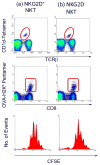Fine tuning a well-oiled machine: Influence of NK1.1 and NKG2D on NKT cell development and function
- PMID: 23800654
- PMCID: PMC3759579
- DOI: 10.1016/j.intimp.2013.05.022
Fine tuning a well-oiled machine: Influence of NK1.1 and NKG2D on NKT cell development and function
Abstract
Natural killer T cells (NKT) represent a group of CD1d-restricted T-lineage cells that provide a functional interface between innate and adaptive immune responses in infectious disease, cancer, allergy and autoimmunity. There have been remarkable advances in understanding the molecular events that underpin NKT development in the thymus and in the complex array of functions in the periphery. Most functional studies have focused on activation of T cell antigen receptors expressed by NKT cells and their responses to CD1d presentation of glycolipid and related antigens. Receiving less attention has been several molecules that are hallmarks of Natural Killer (NK) cells, but nonetheless expressed by NKT cells. These include several activating and inhibitory receptors that may fine-tune NKT development and survival, as well as activation via antigen receptors. Herein, we review the possible roles of the NK1.1 and NKG2D receptors in regulating development and function of NKT cells in health and disease. We suggest that pharmacological alteration of NKT activity should consider the potential complexities commensurate with NK1.1 and NKG2D expression.
Keywords: Adaptive immunity; NK1.1; NKG2D; NKT cells; Pathogenesis.
Published by Elsevier B.V.
Conflict of interest statement
Research contributing to the ideas discussed in this article is supported by NIH grant AI078993 (to M.L.L.) and a pilot award (to M.L.L.) under AI062629. The author has no other relevant affiliations or financial involvement with any organization or entity with a financial interest or financial conflict with the subject matter or materials discussed in the manuscript apart from those disclosed. No writing assistance was utilized in the production of this manuscript.
Figures


References
-
- Taniguchi M, Harada M, Kojo S, Nakayama T, Wakao H. The regulatory role of Valpha14 NKT cells in innate and acquired immune response. Annu Rev Immunol. 2003;21:483–513. - PubMed
-
- Kawano T, Cui J, Koezuka Y, Toura I, Kaneko Y, et al. CD1d-restricted and TCR-mediated activation of valpha14 NKT cells by glycosylceramides. Science. 1997;278:1626–1629. - PubMed
-
- Porcelli SA, Modlin RL. The CD1 system: antigen-presenting molecules for T cell recognition of lipids and glycolipids. Annu Rev Immunol. 1999;17:297–329. - PubMed
Publication types
MeSH terms
Substances
Grants and funding
LinkOut - more resources
Full Text Sources
Other Literature Sources
Medical

